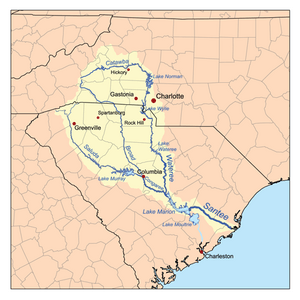Broad River (Carolinas) facts for kids
Quick facts for kids Broad River |
|
|---|---|

The Broad River near Blacksburg, South Carolina
|
|

Map of the Santee River watershed showing the Broad River.
|
|
| Country | United States |
| State | North Carolina, South Carolina |
| Physical characteristics | |
| Main source | Black Mountain, Buncombe County, North Carolina 2,890 ft (880 m) |
| River mouth | Congaree River Columbia, Richland County, South Carolina 128 ft (39 m) |
| Length | 150 mi (240 km) |
| Basin features | |
| Progression | Broad → Congaree → Santee → Atlantic Ocean |
| River system | Broad River |
| Tributaries |
|
For other rivers with the same name, see Broad River (disambiguation). The Broad River is a major river in the United States. It flows for about 150 miles (240 km). You can find it in western North Carolina and northern South Carolina. This river is a main branch of the Congaree River. The Congaree River then joins the Santee River, which flows into the Atlantic Ocean. So, the Broad River is part of a bigger river system that reaches the sea!
Contents
Journey of the Broad River
The Broad River begins high up in the Blue Ridge Mountains. This is in eastern Buncombe County, North Carolina. From there, it flows mostly towards the south and southeast. It passes through or along the edges of several counties. These include Rutherford, Polk, and Cleveland Counties in North Carolina. In South Carolina, it goes through Cherokee, York, Union, Chester, Fairfield, Newberry, and Richland Counties.
Lakes and Forests Along the Way
In North Carolina, the river is blocked by a dam to create Lake Lure. This is a popular spot for fun activities. As the river continues into South Carolina, it flows through the Sumter National Forest. This forest is a protected area with lots of nature. The river also passes by small towns like Cherokee Falls and Lockhart.
Where the River Ends
Finally, the Broad River meets the Saluda River in the city of Columbia. When these two rivers join, they form the Congaree River. This is how the Broad River becomes part of the larger Santee River system.
Smaller Rivers Joining In
Many smaller rivers flow into the Broad River. These are called tributaries. In North Carolina, some of these include the Green River, Second Broad River, and First Broad River. In South Carolina, rivers like the Pacolet, Tyger, and Enoree also add their water to the Broad River.
Dams on the Broad River
Dams are structures built across a river to control its flow. They can create lakes, help prevent floods, or generate electricity. The Broad River has several dams along its path.
- North Carolina:
- Lake Lure Dam: This dam creates the well-known Lake Lure.
- Cliffside Steam Station Dam: This dam is used by a power company.
- South Carolina:
- Gaston Shoals Dam: This dam is near Gaffney.
- Ninety Nine Islands Dam: This dam is next to an old power plant site.
- Lockhart Dam: This dam is part of a canal system.
- Neal Shoals Dam
- Parr Shoals Dam: This dam forms Parr Reservoir.
- Columbia Canal and Dam: This dam is in Columbia, where the river joins the Saluda.
River Crossings
Many roads and highways cross over the Broad River. This allows people and vehicles to travel easily from one side to the other. These crossings include major interstates and smaller local roads in both North Carolina and South Carolina. For example, Interstate 85 crosses the river in South Carolina, and U.S. Route 74 crosses it in North Carolina.
Different Names for the River
Over time, the Broad River has been known by a few different names. Some of these older names include Eswa Huppeday and Line River. In the past, people sometimes called it the English Broad River. This was to tell it apart from the French Broad River, which also starts in western North Carolina but flows in a different direction. The name "Broad River" simply describes how wide the river is in many places.
See also
 In Spanish: Río Broad para niños
In Spanish: Río Broad para niños

